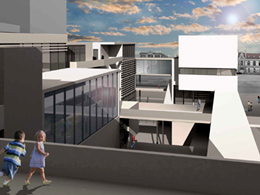STUDENTS PROJECTS
PROJECTS2012

16 April, 2013
In Egyptou street _first turning right
Redesign of two blocks in the district of Ladadika in order to upgrade the urban environment.
Students : Margariti Nikoleta, Mauroudi Sofia
Supervisors : Alexopoulou Aleka
Aristotle University of Thessaloniki, School of Architecture
Date: 17/02/2012

The area known today as "Ladadika" is the oldest part of the town of Thessaloniki and the organic part of the historic commercial center. The vicinity of the port, highlighted previously Ladadika in one of the most lively places in Thessaloniki. But the constant changes occurring in the environment around this area at different times of development as well as the fact that this area was mainly known for its nightlife, resulted in the gradual isolation of the area and the deterioration of its role in relation to the rest of the urban fabric of the historical center.
All these parameters led to a series of theoretical objectives, as requested during the design process. Key priority was to upgrade the urban environment as a result of redesigning the area of interest, with the ultimate goal of reintegrating Ladadika into the urban fabric.
After analysis and evaluation of the current situation, it was more consistent with our objectives to re-design the two selected blocks proposing uses that would allow the creation of local and supralocal interest. Specifically, these uses are grouped into four broad categories:
The need for accommodation of the industrial design museum led us to the creation of the first unit of the proposed uses. The residential use, a condition that ensures the vitality of an area, was needed. Due to the special nature of the area and its proximity to the western entrance of the city, the residential use was proposed through the design of a hostel. The third category was chosen as a result of the recent trend in the region, in terms of space utilization by young professionals-artists. Thus, the creation of a system of artistic and professional workplaces, with simultaneous connection to both the museum and with benefits habitation. Finally, it was decided to maintain the traditional commercial area through a trade zone.
The challenge was the articulation of all these uses through designed public space which is considered as a key tool in the effort to upgrade the urban environment. In our proposal, the public space was the connecting element and an independent category itself with particular emphasis on creating unprecedented for the city spatial qualities in restoring its relationship with the built environment.



















